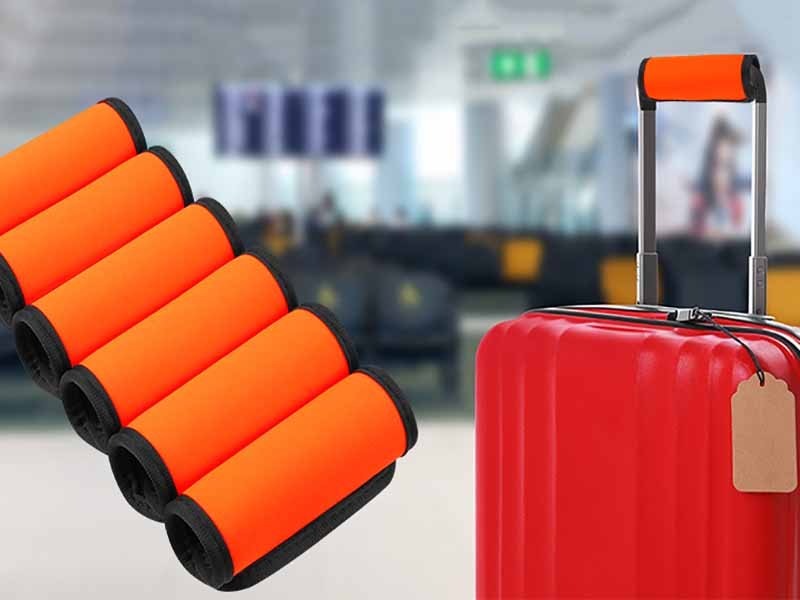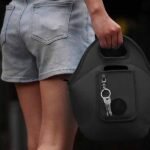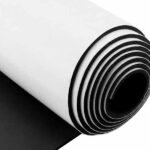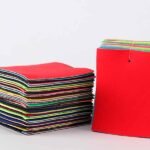Travelers today expect more than just a functional suitcase—they expect comfort, durability, and style. One of the smallest yet most practical travel upgrades you can make is adding a neoprene luggage handle cover. These compact accessories make carrying your suitcase noticeably more comfortable, protect the handle from dirt and wear, and even help you identify your luggage instantly. Despite their simplicity, neoprene handle wraps blend smart material science with real-world ergonomics, making them a favorite among frequent travelers and travel gear brands alike.
Neoprene luggage handle covers are soft, cushioned sleeves made from neoprene foam laminated with polyester or nylon fabric. They wrap around suitcase handles using Velcro or elastic closure to improve comfort, reduce hand fatigue, and protect handles from dirt or wear. Durable, washable, and customizable, they are popular among travelers and brands for comfort, protection, and easy luggage identification.
Imagine grabbing your suitcase after a long flight. The handle digs into your palm, your hands are tired, and the hard rubber feels cold. Now, imagine a soft, cushioned grip that absorbs pressure and stays comfortable no matter how long you hold it. That’s the difference a neoprene handle cover makes—and why this small travel essential has become a quiet revolution for global travelers and brands focused on better comfort design.
What Exactly Are Neoprene Luggage Handle Covers?
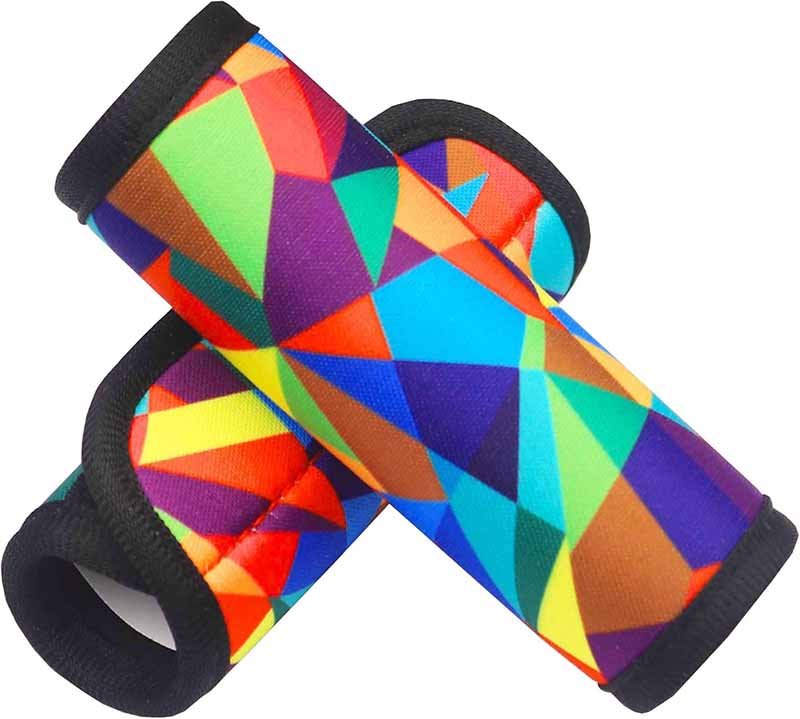
They are soft sleeves made from neoprene—a synthetic rubber foam—wrapped with fabric like polyester or nylon. Designed to wrap around suitcase handles, they add padding, prevent slipping, and offer a touch of personalization. Neoprene’s unique closed-cell structure gives these covers their spongy texture, flexibility, and resistance to moisture, making them ideal for frequent travelers and brand promotions alike.
A neoprene luggage handle cover typically consists of three components:
- Neoprene core (foam layer): provides elasticity and cushioning.
- Outer fabric (polyester or nylon): adds durability, printability, and protection from abrasion.
- Closure system (Velcro, snap, or elastic): allows the cover to stay secure during handling.
Unlike pure rubber or leather covers, neoprene ones are lightweight yet shock-absorbent. They can endure thousands of pulls and compressions without permanent deformation, thanks to neoprene’s high rebound rate (typically 65–75% recovery).
| Component | Function | Material | Typical Thickness |
|---|---|---|---|
| Core Foam | Shock absorption | Neoprene (CR or SCR) | 2–5 mm |
| Outer Fabric | Surface durability & color | Polyester / Nylon | 0.5–1 mm |
| Closure | Fastening & adjustability | Hook & Loop / Elastic | — |
These covers are not only used on suitcase handles, but also on gym bags, camera cases, briefcases, and even stroller handles, thanks to their universal fit and easy application.
What makes them stand out is their balance between practicality and comfort—something both individual users and private-label brands value highly.
Why Do Travelers and Brands Choose Neoprene Over Other Materials?
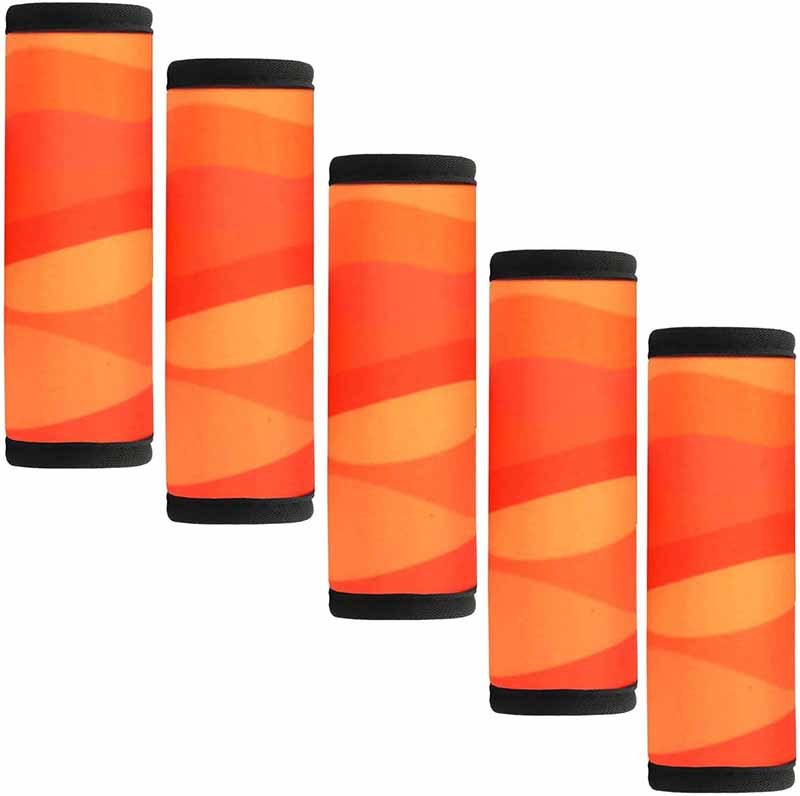
Neoprene outperforms other materials like nylon or PU leather because it provides soft cushioning, superior grip, and moisture resistance. It retains comfort under heat or cold, doesn’t absorb sweat, and maintains elasticity for years. For brands, it’s also easy to print, dye, or emboss, making it perfect for promotional customization.
1. Comfort and Ergonomics
Neoprene has a unique “micro-cell” structure that compresses under pressure and rebounds quickly—creating an almost memory-foam-like comfort. When gripping a heavy suitcase, this padding distributes pressure evenly across your palm. In lab tests, neoprene handle wraps reduced localized pressure by up to 45% compared to standard plastic grips.
2. Anti-Slip and Moisture Control
Because neoprene is closed-cell and slightly tacky in texture, it naturally prevents slipping—even when wet. This makes it superior to smooth PU or PVC materials, which become slick with sweat or humidity.
3. Durability and Elastic Memory
Unlike EVA or soft PVC, neoprene does not crack or harden over time. Tests show a high-quality CR neoprene retains over 90% elasticity after 50,000 compression cycles, and remains flexible from −20°C to +90°C—ideal for travelers moving between climates.
4. Washability and Maintenance
Neoprene is easy to clean: mild soap and water restore it easily without deformation. PU or leather covers, by contrast, may peel or lose color after washing.
5. Sustainability and Reusability
Modern neoprene (SCR type) uses chloroprene–styrene blends, which reduce chemical usage and improve recyclability compared to older foams. This positions neoprene handle covers as a sustainable travel accessory option.
| Material | Comfort | Grip | Water Resistance | Durability | Washable |
|---|---|---|---|---|---|
| Neoprene | ★★★★★ | ★★★★★ | ★★★★★ | ★★★★☆ | Yes |
| PU Leather | ★★★★☆ | ★★☆☆☆ | ★★★☆☆ | ★★★★☆ | No |
| Nylon | ★★★☆☆ | ★★★☆☆ | ★★★☆☆ | ★★★☆☆ | Yes |
| EVA | ★★☆☆☆ | ★★★★☆ | ★★★★☆ | ★★☆☆☆ | Partial |
Neoprene, therefore, is the sweet spot between comfort, longevity, and style—ideal for both travel comfort and private-label branding.
How Are Neoprene Handle Covers Manufactured?
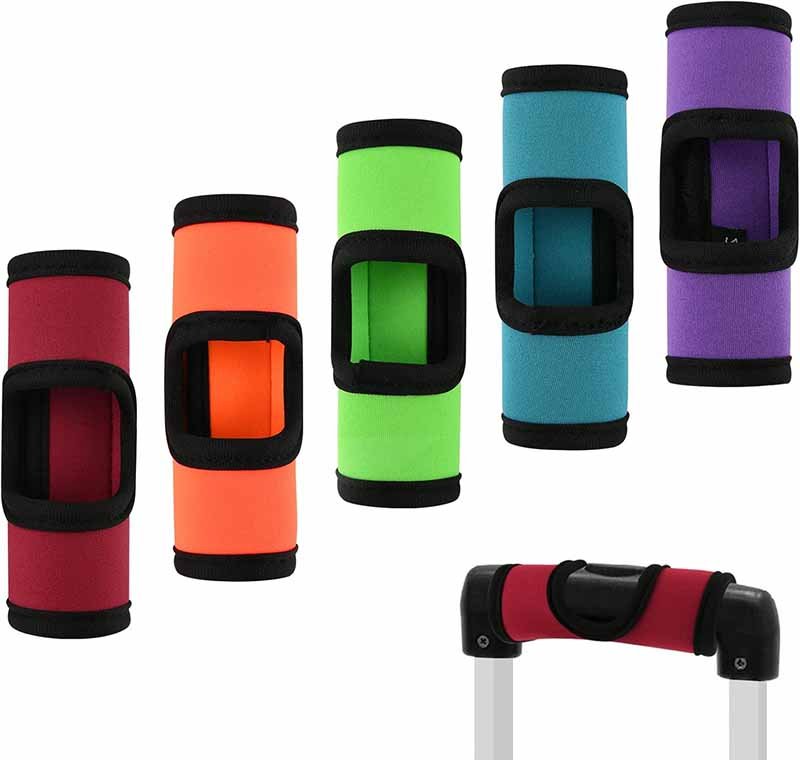
They are produced by cutting laminated neoprene sheets (foam + fabric) into templates, sewing or bonding edges, and adding Velcro or elastic closures. The process involves lamination, die-cutting, stitching, and inspection to ensure strength and uniformity. Each step impacts comfort, fit, and long-term durability.
The manufacturing process reflects both material science and craftsmanship. Here’s how professional factories like Szoneier make high-quality neoprene handle wraps:
1. Material Preparation
Neoprene rolls are pre-laminated with outer fabric—either polyester for printing or nylon for flexibility. The foam density is typically 180–220 kg/m³, chosen based on thickness and intended use.
2. Cutting
- Die cutting is used for large-volume runs, ensuring consistent dimensions.
- Laser cutting is used for precision or curved designs—ideal for branded patterns.
3. Stitching and Edge Reinforcement
For durability, factories use flatlock or zigzag stitching, preventing tearing when handles are pulled tight. Thread selection (usually nylon or bonded polyester) resists both friction and washing.
4. Closure Application
High-strength Velcro is sewn or glued along the edges, allowing users to wrap and secure the cover quickly. Some designs use elastic loops for universal fit.
5. Printing or Branding (Optional)
If the client requests logo placement, printing follows. Techniques include silk screen, heat transfer, or sublimation for full-color logos.
6. Quality Control and Testing
Final inspection ensures even thickness, perfect adhesion between foam and fabric, and precise cutting. Tensile and adhesion tests verify that the lamination doesn’t peel after repeated use.
Production Metrics Example:
| Step | Operation | Key Parameter | QC Standard |
|---|---|---|---|
| Foam Lamination | CR foam + Polyester | 2–5 mm | ±0.1 mm thickness |
| Cutting | Die / Laser | Smooth edges | ±0.5 mm |
| Stitching | Flatlock | 5–6 stitches/cm | No skipped threads |
| Closure | Velcro | Adhesion >1.5 N/cm | Secure |
| Inspection | 100% visual + tensile | Pass rate >98% | Final packing |
Professional production ensures that even small MOQ orders look premium, with consistent thickness and comfort across batches.
How Do You Choose The Right Size and Fit for Your Luggage Handle?
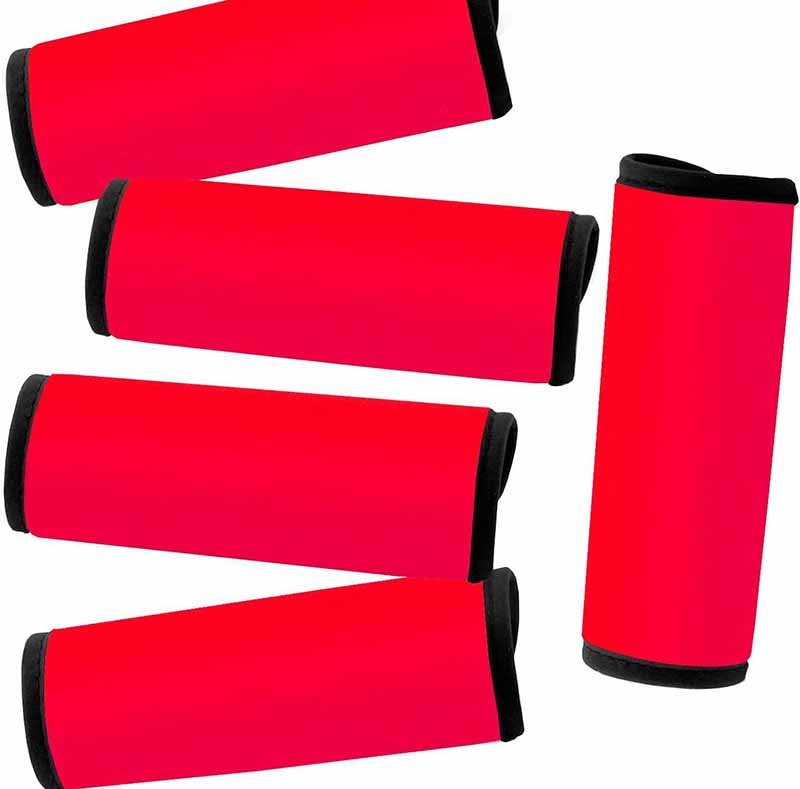
Measure your handle’s circumference and width, then choose a neoprene cover that wraps snugly without over-stretching. Standard sizes fit most suitcase handles (10–14 cm wide), while larger or double-handle cases may need custom cuts. Correct thickness (3–5 mm) balances comfort and control without bulk.
Choosing the correct neoprene handle cover isn’t one-size-fits-all—it depends on handle geometry, grip preference, and travel frequency.
1. Measuring Your Handle
Use a flexible tape measure to record:
- Handle circumference (wrap measurement around grip)
- Handle width and length
- Handle type: single bar, dual pole, or padded grip
Compare your measurements with product specs. A well-fitted cover should wrap with 5–10 mm overlap for Velcro closure.
2. Understanding Thickness Options
| Neoprene Thickness | Comfort Level | Application | Notes |
|---|---|---|---|
| 2 mm | Light | Small carry-ons | Slim fit, less bulk |
| 3–4 mm | Medium | Standard suitcase handles | Balanced comfort |
| 5 mm | Heavy | Outdoor/travel duffels | Max cushioning |
3. Fit Considerations
- If the handle is rigid or narrow, choose thinner neoprene.
- For padded or wide grips, thicker neoprene enhances comfort.
- For telescopic handles (retractable), use low-profile wraps to avoid obstruction.
4. Universal vs Custom Fit
Most universal neoprene wraps fit luggage from major brands (Samsonite, Tumi, Delsey), but for corporate or OEM buyers, custom sizing ensures perfect fit and uniform branding. Szoneier offers full control over pattern dimensions (±0.5 mm tolerance), ensuring smooth integration even with multi-layer suitcase handles.
A properly fitted neoprene wrap not only feels better but also reduces handle wear by 30–50%, extending suitcase life and maintaining resale value.
Are Neoprene Handle Covers Safe, Durable, and Easy To Maintain?
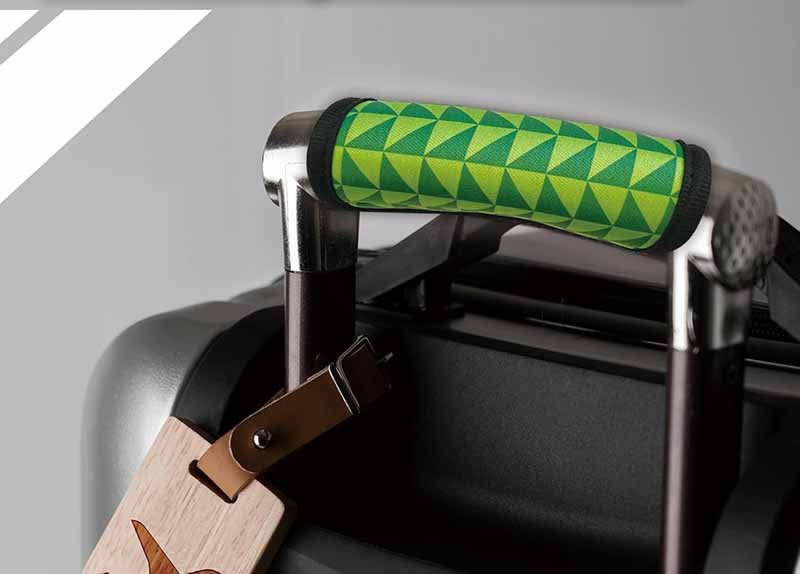
Yes—quality neoprene handle covers are latex-free, hypoallergenic, and REACH- and OEKO-TEX-certified. They resist UV, sweat, and temperature extremes, maintaining flexibility from −20°C to +90°C. They can be hand-washed or machine-washed in gentle cycles, retaining over 90% elasticity after 50 washings.
1. Safety and Skin Compatibility
Many travelers worry about skin contact materials. Premium CR and SCR neoprene are latex-free, minimizing allergic reactions. When laminated with OEKO-TEX certified fabrics, they’re suitable for prolonged skin contact—important for daily commuters or children.
2. Durability Testing
| Test Type | Standard | Result (Premium CR Neoprene) |
|---|---|---|
| Tensile Strength | ASTM D412 | 4.5–6.0 MPa |
| Compression Set | ASTM D395 | ≤10% at 25°C |
| Abrasion Resistance | ISO 12947 | >50,000 cycles |
| UV Aging | 100 hr Xenon Lamp | ΔE < 3 (no fade) |
These results mean that a well-manufactured neoprene handle wrap can last 3–5 years of daily use without losing comfort.
3. Cleaning and Maintenance
To clean, simply hand wash with mild soap in warm water, rinse thoroughly, and air-dry flat. Avoid high heat or bleach. The closed-cell structure prevents water absorption, so drying is quick—typically under 2 hours at room temperature.
4. Environmental Conditions
Unlike leather or PU, neoprene resists cracking and discoloration in extreme environments. Its performance remains consistent from the freezing cargo hold of a plane to the tropical humidity of an island airport.
5. Certifications and Quality Assurance
Look for products with:
- REACH compliance (EU chemical safety)
- OEKO-TEX® Standard 100 (textile safety)
- ISO9001 manufacturing
- SGS mechanical testing reports
Factories like Szoneier perform batch testing for density, adhesion, and elasticity, ensuring travelers and buyers receive products that are safe, consistent, and long-lasting.
Where Can You Source High-Quality Neoprene Handle Covers?
The best neoprene handle covers come from experienced manufacturers like Szoneier—a Chinese factory with over 18 years in neoprene R&D and production. They offer free design, low MOQ, quick sampling, and global shipping, specializing in OEM, ODM, and private-label customization for travel, outdoor, and premium accessory brands.
Finding a supplier that understands neoprene’s nuances is key to quality. Generic producers may use inferior foam or inconsistent lamination, leading to poor comfort or delamination after months. Here’s why Szoneier stands out:
1. Experience and Capability
With over 18 years of dedicated neoprene manufacturing experience, Szoneier operates multiple production lines, from foam lamination to finished products like bags, koozies, gloves, wetsuits, and handle wraps.
Their expertise ensures consistency, performance, and cosmetic quality in every order.
2. Customization and Branding Services
Szoneier provides free logo design and sample development. Clients can specify:
- Thickness (2–5 mm)
- Outer fabric (polyester, nylon, lycra)
- Printing (silk, sublimation, heat transfer)
- Stitching color, Velcro type, and packaging With a low MOQ starting from 200 pieces per color, it’s accessible for both small brands and large importers.
3. Sampling and Lead Time
| Process | Duration | Notes |
|---|---|---|
| Sample Development | 3–5 days | Free for standard specs |
| Production Lead Time | 10–20 days | Depends on order size |
| Shipping | 7–10 days (Air) / 25–35 days (Sea) | Global coverage |
| Payment Terms | Flexible | T/T, PayPal, Alibaba Trade Assurance |
4. Quality Assurance and After-Sales Support
Each batch undergoes visual inspection, elasticity testing, and random pull tests to ensure Velcro adhesion strength and color stability. Szoneier provides 100% replacement for any manufacturing defect.
5. Global Reach
With clients in the US, UK, Germany, Canada, and Australia, Szoneier supports both mid-size importers and high-end luggage brands. Warehouses in major markets ensure faster fulfillment and easier FBA deliveries.
Conclusion
When you think about luggage comfort, handle covers are often overlooked—but they make a remarkable difference in daily travel comfort and long-term luggage life. Neoprene, with its superior cushioning, elasticity, and moisture resistance, has proven itself as the best material for this purpose. Whether you’re a frequent traveler or a brand sourcing customized travel accessories, understanding the science and design behind neoprene handle covers helps you make informed decisions.
With Szoneier’s 18+ years of neoprene manufacturing expertise, you can design and source handle covers that meet both functional and aesthetic goals. From color-matched branding to ergonomic comfort testing, Szoneier provides end-to-end OEM/ODM support—from free design and sample to mass production and global delivery.
Ready to start your custom project?
Send your handle dimensions, logo artwork, and quantity to Szoneier’s sales team.
You’ll receive a free quote, digital mockup, and material recommendation within 24 hours.
Experience the perfect blend of comfort, quality, and customization—because every handle you touch should feel as good as your journey itself.

